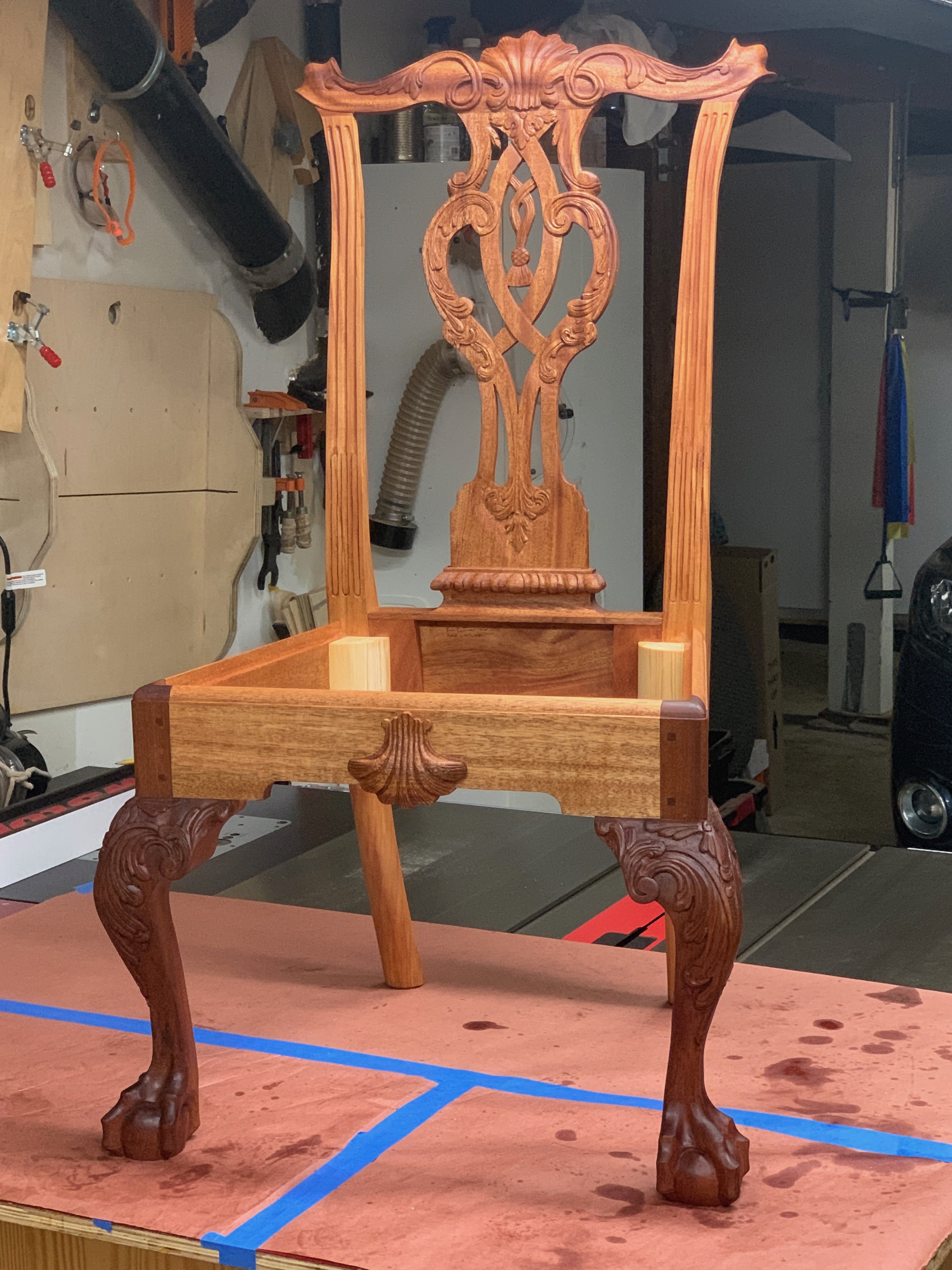African Mahogany
Quote from Todd Vittitow on December 21, 2020, 11:10 pmFolks is African mahogany much different from Honduran mahogany for relief carving? Do people paint mahogany on some carvings or just stain? Sorry if these are stupid questions, I’m new. Thank you.
Folks is African mahogany much different from Honduran mahogany for relief carving? Do people paint mahogany on some carvings or just stain? Sorry if these are stupid questions, I’m new. Thank you.
Quote from MaryMay on December 22, 2020, 9:24 pmHi Todd,
African mahogany can be quite challenging to carve. It is very hard, with squirly grain. Sometimes "sepele" is lumped into the African mahogany group, and if you have ever carved sepele, you will know the challenges. Carving "with the grain" is challenging, as the grain changes quite often. You can see an example of this carving in my oak leaf lesson. Much of the carving had to be done across the grain. Any painting, I would recommend basswood, as the grain is so much more uninteresting than harder woods like mahogany or walnut.
Hi Todd,
African mahogany can be quite challenging to carve. It is very hard, with squirly grain. Sometimes "sepele" is lumped into the African mahogany group, and if you have ever carved sepele, you will know the challenges. Carving "with the grain" is challenging, as the grain changes quite often. You can see an example of this carving in my oak leaf lesson. Much of the carving had to be done across the grain. Any painting, I would recommend basswood, as the grain is so much more uninteresting than harder woods like mahogany or walnut.
Quote from Todd Vittitow on December 23, 2020, 1:44 amThank you for the response, Mary. What woods do you use for your carving?
Thank you for the response, Mary. What woods do you use for your carving?
Quote from MaryMay on December 23, 2020, 8:44 amI use basswood or butternut for beginning projects. Then for anything furniture I use walnut or mahogany. But as noted, the mahogany can be very unpredictable as to what quality/hardness you get. Black walnut is pretty much black walnut. The only differences would be straight grain or squirly grain. The hardness of the wood doesn't seem to vary with walnut. Cherry can also be carved, but is more difficult than walnut. The harder woods simply require more control and really sharp tools! And probably a mallet...
I use basswood or butternut for beginning projects. Then for anything furniture I use walnut or mahogany. But as noted, the mahogany can be very unpredictable as to what quality/hardness you get. Black walnut is pretty much black walnut. The only differences would be straight grain or squirly grain. The hardness of the wood doesn't seem to vary with walnut. Cherry can also be carved, but is more difficult than walnut. The harder woods simply require more control and really sharp tools! And probably a mallet...
Quote from Rob Kutner on November 16, 2023, 9:53 pmMary, what's your experience with African vs Honduran mahogany? I just finished a chair from African mahogany, and learned to my horror that even pieces from the same board take oil in unpredictable ways. The splat, crest rail, and stiles in the attached are all from the same 8/4 board, and the front legs (from a separate 12/4 piece) look like they may as well be a different species. I've read that Honduran mahogany is more consistent both to work and finish.
Mary, what's your experience with African vs Honduran mahogany? I just finished a chair from African mahogany, and learned to my horror that even pieces from the same board take oil in unpredictable ways. The splat, crest rail, and stiles in the attached are all from the same 8/4 board, and the front legs (from a separate 12/4 piece) look like they may as well be a different species. I've read that Honduran mahogany is more consistent both to work and finish.
Uploaded files:Quote from MaryMay on December 8, 2023, 10:21 amWow, that's a beautiful chair! You may be able to speak with a finisher to see how to match the different woods, but that is definitely not my expertise.
The challenge with matching any wood is you need to make sure everything in the piece is sourced from the same place - even the same tree, if possible. And another difficulty is that often when we purchase wood it's rough-sawn and the wood is difficult to view.
I have found that most old growth South American mahogany is pretty consistent. Mahogany these days ranges from very soft (Phillipine) and spongy, and almost blond, to deep brown and dense (African). Definitely a challenging wood to work with when taking random pieces from different locations.
Wow, that's a beautiful chair! You may be able to speak with a finisher to see how to match the different woods, but that is definitely not my expertise.
The challenge with matching any wood is you need to make sure everything in the piece is sourced from the same place - even the same tree, if possible. And another difficulty is that often when we purchase wood it's rough-sawn and the wood is difficult to view.
I have found that most old growth South American mahogany is pretty consistent. Mahogany these days ranges from very soft (Phillipine) and spongy, and almost blond, to deep brown and dense (African). Definitely a challenging wood to work with when taking random pieces from different locations.
Quote from Ed Frank on December 15, 2023, 8:04 pmMy reply will be too late to be helpful, but in case it helps in the future: One thing I was taught by Charles Neil was to skim the wood and apply some finish right when you are milling it. Sometimes, this is just to explore colors on a surface you are going to plane away into the chip bin. Other times (like here), it might let you see how different bits of the wood will respond. As you can guess, this is no small amount of work. But, this can happen later in the project, especially if you are working with figured wood or wood with strong chatoyance. For both of those, whether you flip a board one end up or the other way around can determine whether it looks light or dark and whether the figure comes out or not. So, Charles Neil would trace coat material that had been milled so that he could see the figure and orient the boards. There was Queen Anne desk with hutch, if I recall correct, for which this was really important (because of the particular wood). I am actually wondering, if you take your chair and flip it upside down, do the dark legs look light and the light rails look dark, i.e., does the problem flip around? It doesn't look like chatoyance in the photo, so I doubt it, but still curious. I've wiped mineral spirits onto things to see what they will look like. I don't know if that would work here. It can take awhile for the spirits to fully clear off the surface (like weeks), but this hasn't been a problem. In any case, that's a beautiful chair and beautiful work!
My reply will be too late to be helpful, but in case it helps in the future: One thing I was taught by Charles Neil was to skim the wood and apply some finish right when you are milling it. Sometimes, this is just to explore colors on a surface you are going to plane away into the chip bin. Other times (like here), it might let you see how different bits of the wood will respond. As you can guess, this is no small amount of work. But, this can happen later in the project, especially if you are working with figured wood or wood with strong chatoyance. For both of those, whether you flip a board one end up or the other way around can determine whether it looks light or dark and whether the figure comes out or not. So, Charles Neil would trace coat material that had been milled so that he could see the figure and orient the boards. There was Queen Anne desk with hutch, if I recall correct, for which this was really important (because of the particular wood). I am actually wondering, if you take your chair and flip it upside down, do the dark legs look light and the light rails look dark, i.e., does the problem flip around? It doesn't look like chatoyance in the photo, so I doubt it, but still curious. I've wiped mineral spirits onto things to see what they will look like. I don't know if that would work here. It can take awhile for the spirits to fully clear off the surface (like weeks), but this hasn't been a problem. In any case, that's a beautiful chair and beautiful work!

